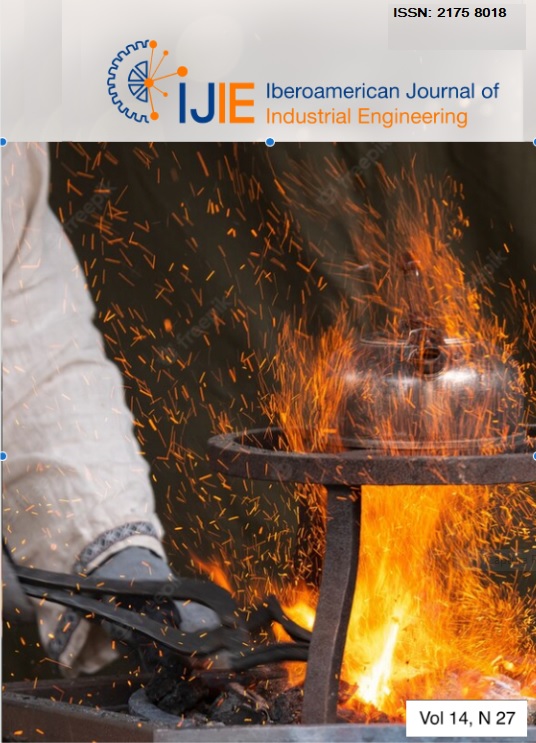SMED TO INCREASE PRODUCTIVITY: A CASE STUDY IN AN AUTOMOBILE INDUSTRY
Palavras-chave:
SMED, Melhoria Contínua, Kaizen, SetupResumo
With increasing competitiveness, companies have sought tools to obtain advantages and improvements in the production system. The Lean Manufacturing philosophy, created by the Toyota Production System, has brought several tools to help decision making, reduce production costs and increase competitive advantage. One such tool is SMED, which has the principle of reducing setup time. The purpose of this paper is to be an example of how the tool, created by the Japanese Shingeo Shingo and brought to the West after the Second World War, is applied to different types of industries, more specifically in the automobile industry. This article was based on a case study at a multinational that serves large automakers in Brazil and abroad. With the application of the tool, the factory was able to eliminate one of its great losses.
Referências
Aoki K (2008) Transferring Japanese Kaizen activities to overseas plants in China. Int J Oper Prod Manag 28(6):518–539
CAMPOS, V. F.; TQC: Controle da Qualidade Total (no estilo japonês). Belo Horizonte, MG: Editôra de Desenvolvimento Gerencial, 1999.
Fogliatto, Flávio Sanson, & Fagundes, Paulo Ricardo Motta. (2003). Troca rápida de ferramentas: proposta metodológica e estudo de caso. Gestão & Produção, 10(2), 163-181
Gershengorn HB, Kocher R, Factor P. Management strategies to effect change in intensive care units: lessons from the world of business. Part II. Quality-improvement strategies. Ann Am Thorac Soc 2014;11:444-53.
Jagdeep Singh, Harwinder Singh, (2018) "Enigma of KAIZEN approach in manufacturing industry of Northern India – a case study", International Journal of Quality & Reliability Management, Vol. 35 Issue: 1, pp.187-207
Muhammad, S. (2015). Quality improvement of fan manufacturing indus-try by using basic seven tools of quality: A case study. InternationalJournal of Engineering Research and Applications, 5,30–35
McINTOSH, R. I.; CULLEY, S. J.; MILEHAM, A. R. A critical evaluation of Shingo's `SMED' methodology. Int. J. Production Research, v. 38, n. 11, p. 2377-2395, 2000.
QUINQUIOLO, J. M. Avaliação da Eficácia de um Sistema de Gerenciamento para Melhorias Implantado na Ãrea de Carroceria de uma Linha de Produção Automotiva. Taubatéâ„SP: Universidade de Taubaté, 2002.
OHNO, T. (1997) - O Sistema Toyota de Produção: além da produção em larga escala. 1.ed. Porto Alegre: Artes Médicas, 1997.
SHARMA, A. MOODY, P. E. (2003) - A Máquina Perfeita; Como vencer na nova economia produzindo com menos recursos. Trad. Maria Lúcia G. Leite Rosa. 1.ed. São Paulo: Prentice Hall.
SHIBA, S.; GRAHAM, A.; WALDEN, D. TQM: quatro revoluções na gestão da qualidade. Porto Alegre, Artes Médicas, 1997.
SHIGEO, Shingo (2000), “Troca rápida de ferramentas†Ed. Bookman, Vol 1, 328p.
Singh, J. and Singh, H. (2010), “Assessment of continuous improvement approach in SMEs of Northern Indiaâ€, International Journal of Productivity and Quality Management, Vol. 5 No. 3, pp. 252-268.
TAIICHI, Ohno (1988), “Toyota Production Systemâ€, Ed. Hardcover, 176p.
Downloads
Publicado
Como Citar
Edição
Seção
Licença
Os artigos publicados são de propriedade do IJIE – Iberoamerican Journal of Industrial Engineering, Revista Iberoamericana de Engenharia Industrial, Revista Iberoamericana de Ingeniería Industrial. Os autores são os responsáveis pelos conteúdos dos artigos. O IJIE não se responsabiliza ou endossa as opiniões emitidas pelos autores dos textos publicados, salientando que as opiniões são de exclusiva responsabilidade dos autores.
O periódico se reserva o direito de introduzir alterações no original, visando a manter a homogeneidade e a qualidade da publicação, respeitando, no entanto, o estilo e as opiniões dos autores. Essas alterações serão editoriais (correções gramaticais e adequações estilísticas) e não substanciais, de forma que não modifiquem o sentido do texto. As provas finais não serão enviadas aos autores, sendo o artigo publicado com os ajustes necessários.
Conforme citado neste site, no item “Caráter do IJIE”, os artigos são de uso gratuito, com atribuições próprias em aplicações educacionais e não-comerciais. Uma nova publicação do mesmo texto, de iniciativa de seu autor ou de terceiros, fica sujeita à expressa menção da precedência de sua publicação neste periódico, citando-se a edição e a data dessa publicação.

